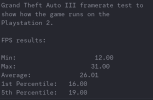It's exactly what I said here that's been ignored and you and davis.anthony have dropped a personal crapper in this thread that's shameful.I wouldn't know about vc nor care. The gt3 section literally ran 23 to 30 fps . Including cutscenes. That simple. So it did constantly fall below 25 fps.
You said "Falls below 25 fps all the time on PS2. That's the truth," without qualifying to counter this idea that there's a big disparity between the two versions' framerates. davis.anthony said "[GTA] holds 30fps very well".
I said people need to be specific and choose something like the 95% percentile, but you just stuck with your number and stretched the definition over and over to not admit your information wasn't appropriate. david.anthony tried to make sense of your statement and the only that did to him is you were counting VC's framerate, not GTAs.
Does GTA dip to 25 fps on PS2? Yes. Does it do it 'all the time'? What does 'all the time' mean? Watch the video you linked and most of the time during that video, the amount of time a framerate is shown, the framerate is 29-30, sometimes 28. It dips down to 25 in two instances for a fraction of a second. There's no way that can be categorised as "falls below 25 fps all the time", or if it is, you need to say the DC version drops to 5 fps all the time, or whatever fair comparison would be.
I said earlier this is just supposed to be fun thread. Anyone who can't engage in a fun technical discussion without an emotional attachment to the outcome - etiher side - will be banned from this thread.
To compare framerates between the DC GTA build and the PS2 build, use the 95% of time framerate. You can call PS2 29 fps if you want. Or do proper metrics and produce a box-plot of min-median-interquartiles-max framerates or something.
Last edited:

